|
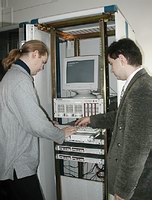 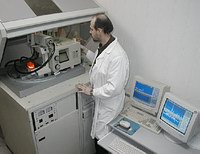 The REC incorporates 20-processor high-efficiency computing cluster that consists of four-processor server SUPERSERVER 8060 (4xCPU Pentium III Xeon, 700 MHz, 4 GB SDRAM), four dual-processor servers SUPERSERVER 6010H (2xCPU Pentium-III, 1.13 GHz, 1 GB SDRAM), eight workstations (Pentium-4, 2.0 GHz, 512 MB RIMM). The peak productivity of the cluster is 28 Gflops. Computing cluster capacity provides the conditions for the complex calculations and computing experiments with the educational and scientific goals. The REC incorporates 20-processor high-efficiency computing cluster that consists of four-processor server SUPERSERVER 8060 (4xCPU Pentium III Xeon, 700 MHz, 4 GB SDRAM), four dual-processor servers SUPERSERVER 6010H (2xCPU Pentium-III, 1.13 GHz, 1 GB SDRAM), eight workstations (Pentium-4, 2.0 GHz, 512 MB RIMM). The peak productivity of the cluster is 28 Gflops. Computing cluster capacity provides the conditions for the complex calculations and computing experiments with the educational and scientific goals.
The REC is equipped with a device for voltage and capacity characteristics control in semiconductors, which includes a system for measuring parameters of semiconductor structures CSM/Win-VF6 on the basis of the capacity and conductivity meter HP-4284 with a variable signal frequency from 100 Hz up to 1 MHz with digital control of the bias voltage ±40 Volts and integrated computer control and full software package CSM/Win under Windows operation system. It includes the software for tracing voltage-capacitance characteristics of MOS-structures, engineer software for calculating semiconductor structures, measurements of charge carrier lifetime, software for calculating dependence of concentration of charge carriers on the thickness, calculating the density of surface states on the face boundary, and also a three-functional mercury probe 811-150 with coaxial ring contacts.
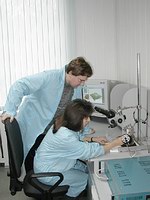 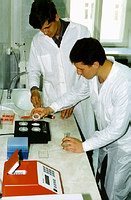 Studies of structural characteristics of crystalline, polycrystalline and amorphous materials are carried out in the laboratory x-ray structural research of the REC using the automatic diffractometer DRON-4. The techniques developed in the REC enables determining phase structure and periods of a crystalline lattice, types of solid solutions, sizes of crystallites and texture degree of the samples under investigation, to study internal stress and plastic deformation of crystalline samples, to determine the nature and concentration of impurities in minerals, to reveal the nature of isomorphic replacements, to study the character of structural changes during polymorphic transformations and kinetics of phase transformations under the influence of various external factors. Studies of structural characteristics of crystalline, polycrystalline and amorphous materials are carried out in the laboratory x-ray structural research of the REC using the automatic diffractometer DRON-4. The techniques developed in the REC enables determining phase structure and periods of a crystalline lattice, types of solid solutions, sizes of crystallites and texture degree of the samples under investigation, to study internal stress and plastic deformation of crystalline samples, to determine the nature and concentration of impurities in minerals, to reveal the nature of isomorphic replacements, to study the character of structural changes during polymorphic transformations and kinetics of phase transformations under the influence of various external factors.
The REC laboratory of nanoscopy and of nanotechnology uses the unique equipment and techniques for studies of various nanoobject: dielectric, conductor or semi-conductor materials of organic and inorganic origin. The laboratory is equipped with scanning probing microscope FemtoScan-001, which allows to visualize topography of the surface of the investigated objects with 1 nm resolution, to study surface and volumetric changes of sorbents during interaction with physiologically active substances, enables acquiring the three-dimensional surface images of various physical objects.
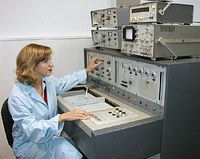 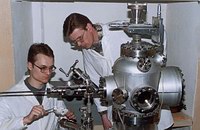 Liquid micro column chromotograph “Millichrom –5-6” represents the analytical complex providing the component separation of an analyzed mixture, detection, the quantitative and qualitative analysis of components using the high efficiency method of micro-column liquid chromatography. This method is mainly used in: the chemical industry, ecology, control of organic synthesis products, medicine, pharmaceutics, criminalistics, power engineering, agriculture etc. The mentioned chromotographer is particularly widely applied in the environmental control, including the control of sewage and waste products, the control of drinking water, quality and safety control of foodstuffs and agricultural production. Liquid micro column chromotograph “Millichrom –5-6” represents the analytical complex providing the component separation of an analyzed mixture, detection, the quantitative and qualitative analysis of components using the high efficiency method of micro-column liquid chromatography. This method is mainly used in: the chemical industry, ecology, control of organic synthesis products, medicine, pharmaceutics, criminalistics, power engineering, agriculture etc. The mentioned chromotographer is particularly widely applied in the environmental control, including the control of sewage and waste products, the control of drinking water, quality and safety control of foodstuffs and agricultural production.
The laboratory of molecular biology is equipped with an amplifier for carrying out polymeraze chain reaction (PCR), with electrophoresis systems in agarose and polyacrylamide gel, including electrophoresis system for sequencing DNA, Eppendorf-compatible centrifuges, blot-system, a refrigerator that keeps temperature of -700C, thermostats, vortices, sterile boxing, autoclave, distiller, pH-meters, analytical balance and precision thermostatic water bath. The specified equipment allows carrying out amplification of genome loci with the help of PCR, cloning of them in vector systems, restriction analysis, blotting, homological or heterological hybridization. The REC has mastered the technique of DNA and RNA isolation from micro quantities of vegetative and animal tissues. The laboratory has the equipment for proteins separation (columns for ion-exchange and gel-chromotography, cold room).
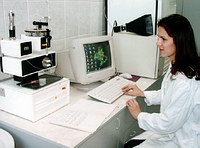 Together with fundamental research the REC supports applied research relevant to electronic industry (semiconductors, optoelectronics etc.), metallurgy (moulding, powder metallurgy, defectoscopy), chemical and microbiological industry, including the manufacture and analysis of foodstuffs, geological prospecting, pharmaceutical industry, ecological and medical control. Together with fundamental research the REC supports applied research relevant to electronic industry (semiconductors, optoelectronics etc.), metallurgy (moulding, powder metallurgy, defectoscopy), chemical and microbiological industry, including the manufacture and analysis of foodstuffs, geological prospecting, pharmaceutical industry, ecological and medical control.
REC shares the use of its equipment with Scientific center of wave research of General Physics Institute of Russian Academy of Science, Moscow Institute of Radio Engineering, Electronics and Automatics, Voronezh State Technical University, Voronezh Scientific Research Institute of Communication, Tambov State University, Lipetsk State Technical University, other academic and scientific institutions of the Central Black-soil region.
|

